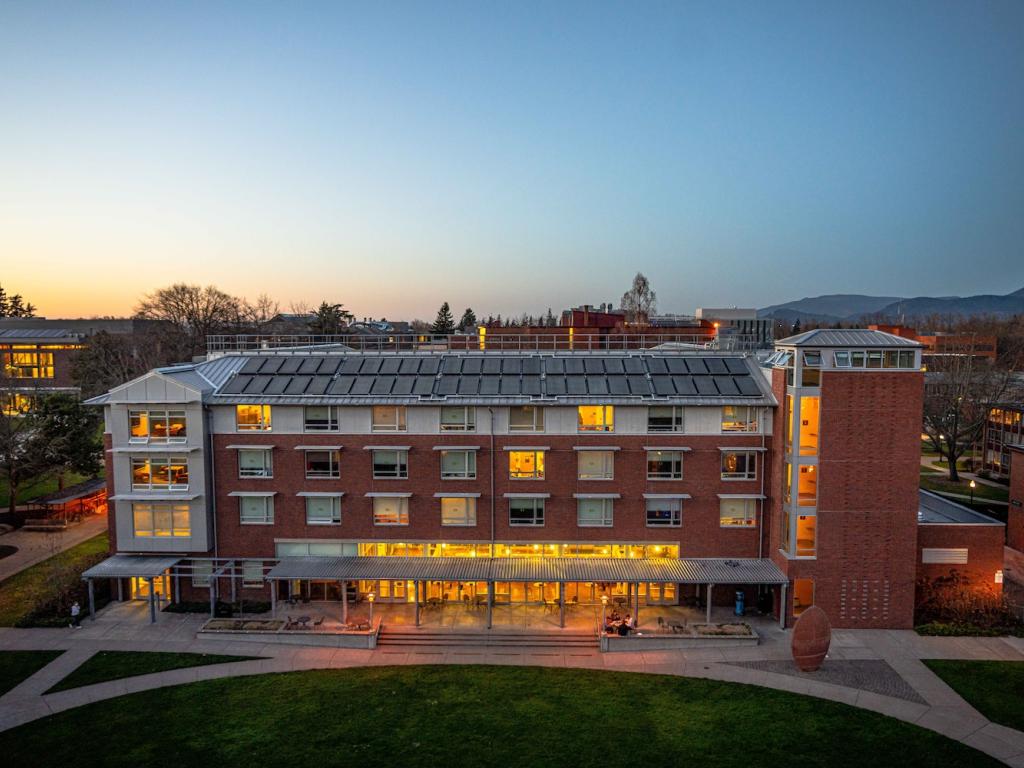
It’s unsurprising that the process of decarbonizing a system that has known no other source of energy is long and difficult. At the University of Oregon, that process has focused on incremental improvements to energy efficiency in buildings. But a task force and its creative problem solving has created a much deeper understanding of university-wide improvements that could lead to more substantial decarbonization.
The Perfect is the Enemy of the Good
In 2010, the UO’s Office of Sustainability submitted the university’s first climate action plan, which included an emissions inventory and a goal to eliminate institutional emissions by 2050 but lacked detailed steps to achieve it.
In 2018, as the university prepared to unveil an updated climate action plan, a group of undergraduate students advocated for an addendum to the plan that had more systematic and realistic emissions-reduction goals and projects.
The second climate action plan, which ends this year, made a list of commitments. One of the resulting actions was the creation of the Thermal Systems Task Force, which was formed in 2022 and has since reviewed the UO’s heating infrastructure. The task force, comprised of students, faculty, and staff, has submitted its recommendation to President Karl Scholz on how best to reduce the system’s greenhouse gas emissions.
Brendan Adamczyk, a graduate student in the Department of Planning, Public Policy, and Management in the College of Design, has participated in the decarbonization process twice—once as an undergraduate and now as a graduate student. He became involved with the task force after participating in the 2018 student effort to be more included in institutional climate action planning.
“The university is a small city, so it’s understandable why its energy systems are so complex,” he said.
Much of the task force’s efforts have been in understanding the full scope and complexity of the issue and working closely with consulting engineers and conducting stakeholder engagement to ensure that campus constituencies fully understand the issues at play.
“We looked at the budget situation; engaged an engineering firm; met with students, faculty, and staff in different departments; met with Campus Planning and Facilities Management; and we went on a tour of the campus power plant—did you know there are four miles of steam pipes? The whole process has been an application of my degree at a university-level,” Adamczyk said.
Brian Fox, associate vice president for budget, financial analysis, and data analytics, co-facilitated the task force with Steve Mital, director of energy and sustainability.
Fox noted that, “The task force included experts from across the campus, including faculty with deep knowledge in energy policy, material sciences, the built environment as well as finance, capital construction, and our energy systems. This expertise allowed us to understand and vet the full scope of information to create a truly informed recommendation.”
Fox said that the task force decided that the economics of a steam-to-hot-water-based heat distribution system were not a good fit for the UO.
The task force’s recommended shift comes in the form of an 8-megawatt electrode boiler rather than the full replacement of the steam-pipe system, the installation of an 18-megawatt boiler, or a combined heat pump chillers and geo-exchange system, which were considered as other options.
Autonomy, But in Context
“As a university, we have the autonomy to claim control over our emissions,” Adamczyk said.
However, that autonomy comes at an immediate price. Any option recommended by the task force will result in an increased cost for campus operations—something the task force believes is inevitable to some degree or another either by the institution adjusting its heat production system or through regulatory pressure on natural gas providers.
During the task force process, the State of Oregon’s marquee environmental action over the past decade, the Climate Protection Plan, was invalidated by the Oregon Court of Appeals after a successful lawsuit by fossil fuel companies and others. This was just one major, and unanticipated, shift in the marketplace that the university will have to manage through in the coming years.
“R&D in this sector is at an all-time high, and our taskforce recognized that now is not the time for an all-in commitment,” said Steve Mital, director of the Office of Sustainability and task force co-facilitator. “Instead, we recommended a strategic investment in an 8-megawatt electric boiler that cuts annual emissions in half now and buys time for technology to mature. For the next several years it will provide baseload heating but someday it will be repurposed to meet peak heating demand.”
While going all-in on a larger boiler would reduce the UO’s emissions even more rapidly, the task force determined that allowing green tech to advance further was a better long-term plan.
The task force recommendation also includes a structured study period, led by the Office of Sustainability, to evaluate regulatory and technology changes and queue up additional investment if or when it becomes feasible. The recommendation, which intentionally pairs immediate reductions in greenhouse gas emissions—allowing the university to stay directionally consistent with local, state, and national climate commitments—with a systematic evaluation of the rapidly changing landscape, is a hallmark of the UO’s multi-disciplinary approach.
Though some may argue that the task force’s recommendation to the president doesn’t go far enough, it represents a significant step forward built on the best information available, understanding of the shifting regulatory environment, increasing investment in technological innovation, and deep and intentional stakeholder engagement.
“A lot of people saw this as an opportunity for massive transformation. While we aren’t reaching a zero emissions target, in the first year the recommended new boiler will cut emissions in half,” Adamczyk said. “I feel proud of what we’ve done. I think our university will be at a level that most others aren’t. We will be ahead of the curve, and it’s largely because of student power.”
— By Kelley Christensen, Office of the Vice President for Research and Innovation
